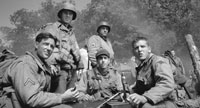SdKfz 2 kleines Kettenkrad
Originally designed as a lightweight artillery tractor for German airborne and paratroop forces, the Sonderkraftwagen 2 kleines Kettenkraftrad (usually abbreviated as simply "Kettenkrad") first entered service in 1941. Due to Luftwaffe setbacks, the Kettenkrad was mainly used as a specialized, all-terrain supply vehicle. Although capable in that role, the Kettenkrad had limited cargo and towing capacity, and had not been built in large enough numbers for widespread use.
Only two significant sub-variations of the Kettenkrad were constructed, and production of the vehicle was stopped in 1944, at which time 8,345 had been constructed. (There was limited production of Kettenkrads after the war for civilian use).
During the defense of the French village of Ramelle on June 13, 1944, an abandoned Kettenkrad was used by American Rangers and paratroopers in order to draw the attention of German forces that were amassing just outside the village in preparation for an attack. Employing the Kettenkrad as bait, the American troops were able to draw a German tank into the narrow streets of Ramelle and disable it with sticky bombs.
Notes
Captain Miller refers to the Kettenkrad as a "rabbit" due to its role as bait for the German tanks. A total of five Kettenkrads were used by the production crew of Saving Private Ryan.
Fact vs. Fiction
One of the Kettenkrads is marked with the insignia of the 7th Fliegar (Flying) Division, a unit that would not have been near Normandy in early June of 1944.

